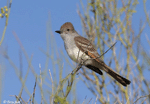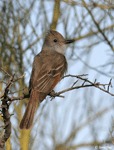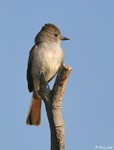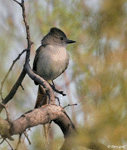| Length: 8.5 inches | Wingspan: 12 inches | Seasonality: Non-resident in South Dakota |
| ID Keys: Gray overall with pale yellow belly, darker wings with rusty color, rusty color on tail | ||
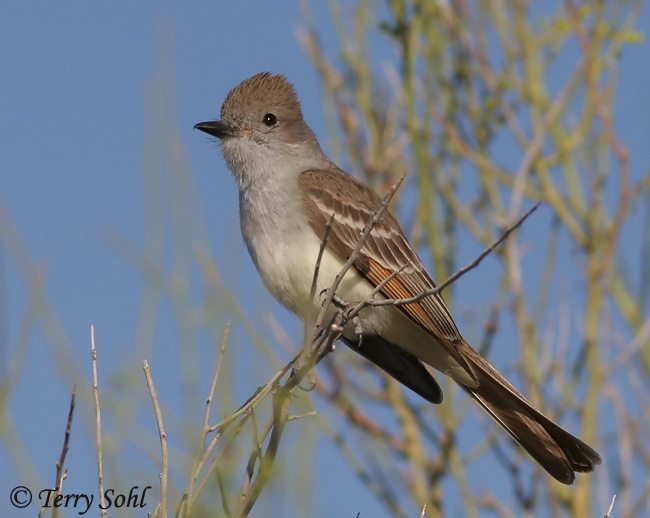 The
Ash-throated Flycatcher is a common bird of semi-arid areas of the western
United States and Mexico. They have several closely related species
that are very similar in appearance (Dusky-capped Flycatcher,
Brown-crested
Flycatcher, and Great Crested
Flycatcher), and in the United States, there is some minor overlap in
range between the species. Most notably, southern Arizona may have
populations of Ash-throated Flycatchers, Dusky-capped Flycatchers, and
Brown-crested Flycatchers. However, in the western U.S. as a whole,
the Ash-throated Flycatcher is by far the most widespread and common.
While mostly a bird of the West, strays do seem to show up as far as the
Atlantic Coast many years.
The
Ash-throated Flycatcher is a common bird of semi-arid areas of the western
United States and Mexico. They have several closely related species
that are very similar in appearance (Dusky-capped Flycatcher,
Brown-crested
Flycatcher, and Great Crested
Flycatcher), and in the United States, there is some minor overlap in
range between the species. Most notably, southern Arizona may have
populations of Ash-throated Flycatchers, Dusky-capped Flycatchers, and
Brown-crested Flycatchers. However, in the western U.S. as a whole,
the Ash-throated Flycatcher is by far the most widespread and common.
While mostly a bird of the West, strays do seem to show up as far as the
Atlantic Coast many years.
Habitat: Found in semi-arid, relatively open landscapes of the western U.S. and Mexico. They are usually found at lower elevations in areas such as deserts with scattered cactus and shrub, groves of mesquite, and stands of pinyon-juniper. They avoid dense unbroken forest, but can sometimes be found in open woodlands and near woodland edges.
Diet: Feeds on insects and spiders, and more rarely, small vertebrates such as tiny lizards. Especially during the winter, they may also feed heavily on fruits and berries.
Behavior: Foraging is usually done by flying out and hovering to pluck an insect from a plant's surface. They will also sometimes climb through the vegetation to hunt for insects, or forage on the ground.
Nesting: The nest is a cavity in a tree, a large cactus, or sometimes a cavity in a man-made object such as a telephone pole or fence post. They will use natural cavities, as well as those previously excavated by woodpeckers. The nest is lined with grasses, leaves, roots, hair, and feathers. The female lays 4 or 5 eggs, and she alone incubates the eggs. Upon hatching, both parents help to feed the young. In many areas, they will raise two broods per year.
Interactive eBird Map: Click to access an interactive eBird map of Ash-throated Flycatcher sightings
Song: Song of the Ash-throated Flycatcher is a series of repeated k-brrrk phrases, with the call somewhat similar but one phrase..
Migration: Populations in the U.S. are strongly migratory, with most birds retreating to Mexico for the winter. Some overwinter in southern Arizona and California, but these likely represent birds that have moved southward from more northerly breeding locations.
Similar Species: Dusky-capped Flycatcher, Brown-crested Flycatcher, Great-crested Flycatcher
Conservation Status: Populations of Ash-throated Flycatchers are large, are stable or even increasing, and are spread across a wide geographic region. The IUCN lists the Ash-throated Flycatcher as a species of "Least Concern".
Further Information: 1) Audubon Guide - Ash-throated Flycatcher
2) BirdWeb.org - Ash-throated Flycatcher
3) California Partners in Flight - Ash-throated Flycatcher
Photo Information: Photo taken on May 7th, 2008 on the outskirts of Tucson, Arizona - Terry Sohl
| Click below for a higher-resolution map |
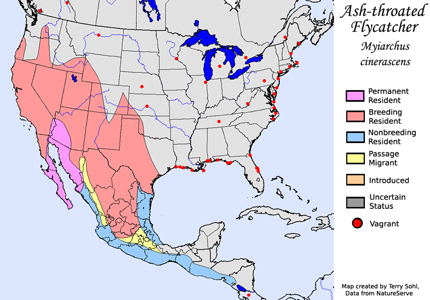 |
| South Dakota Status: Non-resident in South Dakota |
Additional Ash-throated Flycatcher Photos
Click for a higher-resolution version of these photos
